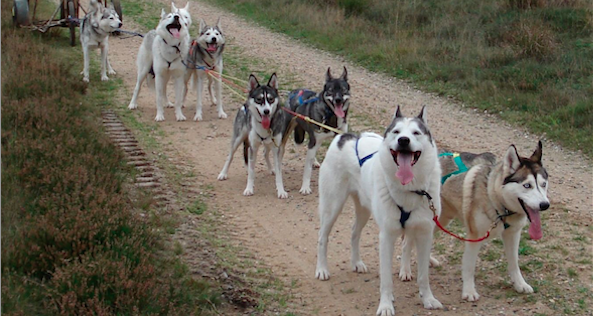 foto: Juno and Bree in there first summer in 2006 - maybe they can see "The Little Man with His Little Dogs" looking down from heaven, with Togo beside him, enjoying his leon heart?
foto: Juno and Bree in there first summer in 2006 - maybe they can see "The Little Man with His Little Dogs" looking down from heaven, with Togo beside him, enjoying his leon heart?
The musher legend from Norway, born 1877!
In the year 2009 it is exactly 100 years since the team of Siberians was to be entered in the 1909 All Alaska Sweepstakes race of 656 km. The Siberian dog, later to be known as the Siberian Husky, importet to Nome, Alaska, the year befor, by the Russian fur trader William Goosak. No one was impressed with Goosak's little dogs, waighing only 20 to 26 kg. http://www.nomekennelclub.com/
Goosak persuaded Louis Thustrup, a Danish sailor, to drive his team. This team, even though the odds were 100 to 1 against it in the betting, made a tremendous showing and nearly won the race, placing third.
The year after, the legendary John "Iron Man" Johnson team of Siberians finished first in the 1910 All Alaska Sweepstakes, the team completed the race in 74 hours, 14 minutes, 37 seconds. This time was never equaled. Hes Siberians were importet by Fox Ramsay, who also partisipated and placing third. In 1914 the "Iron man" won again.
In 1913, Jafet Lindeberg, Leonhard Seppalas employer, acquired what was left of the first Siberian imports and there offspring, around 15 animals in all. They were to be a gift to the explorer Captain Roald Amundsen, who was planning a expedition to the North Pole. Seppala was given the job of the care and training of the dogs in Alaska, and he loved it.
Short after, Amundsen gave up his North Pole trek due the start of World War 1. Seppala continued to train the Siberians and entered the 1915 All Alaska Sweepstakes, which he finished first. He repeted this victory in 1916 and 1917, at which time the United States entery in World War 1 ended the great race series.
In 1925, Seppala and his Siberians came to national prominence, with the famous "Serum Run" that saved the city of Nome from a diphtheria epidemic. Seppala and his Seberians, with his famous lead dog Togo, covered 261 miles in that race against death, with no other team traveling more than 53 miles, with the serum. http://www.shca.org/
In 1930 Seppala handed over his dogs to Harry Wheeler, kennel Seppala.
In 1930 Seppala handed over his dogs to Harry Wheeler, kennel Seppala.

